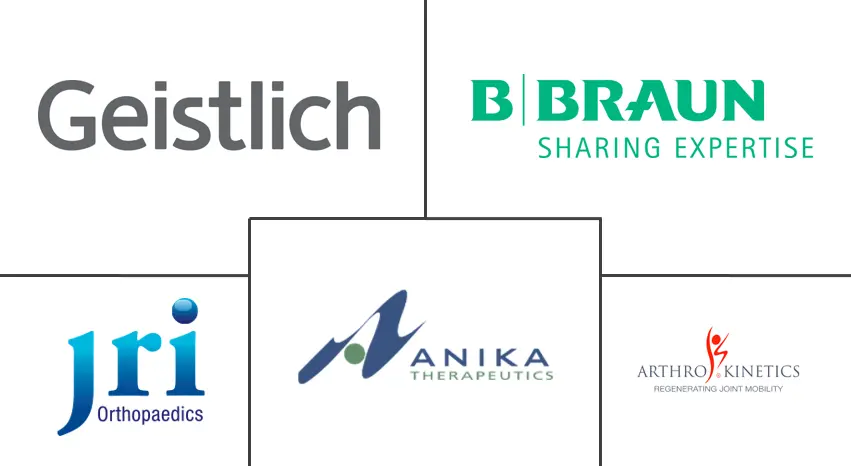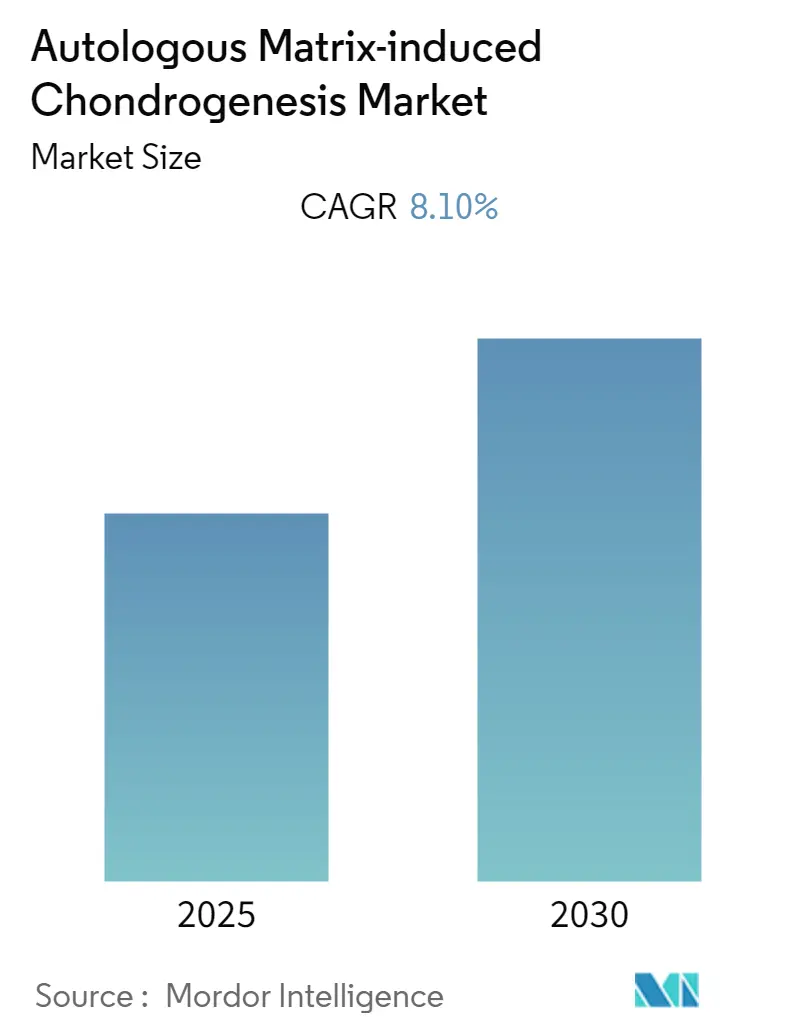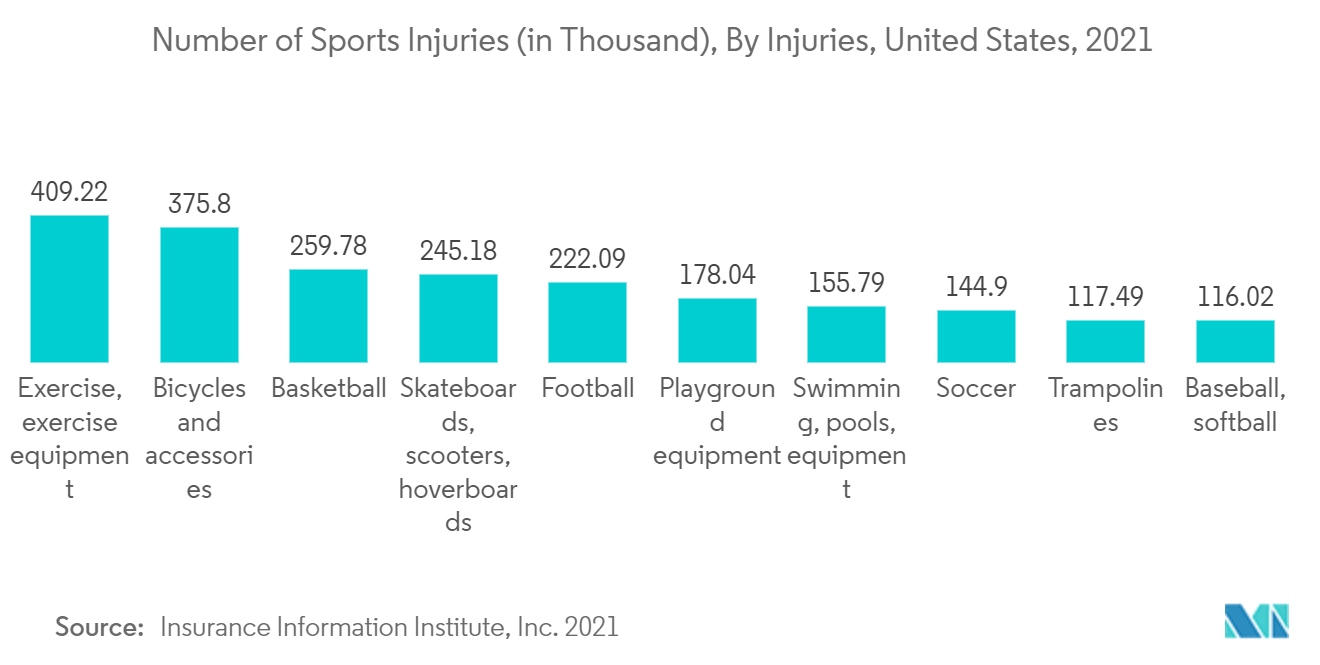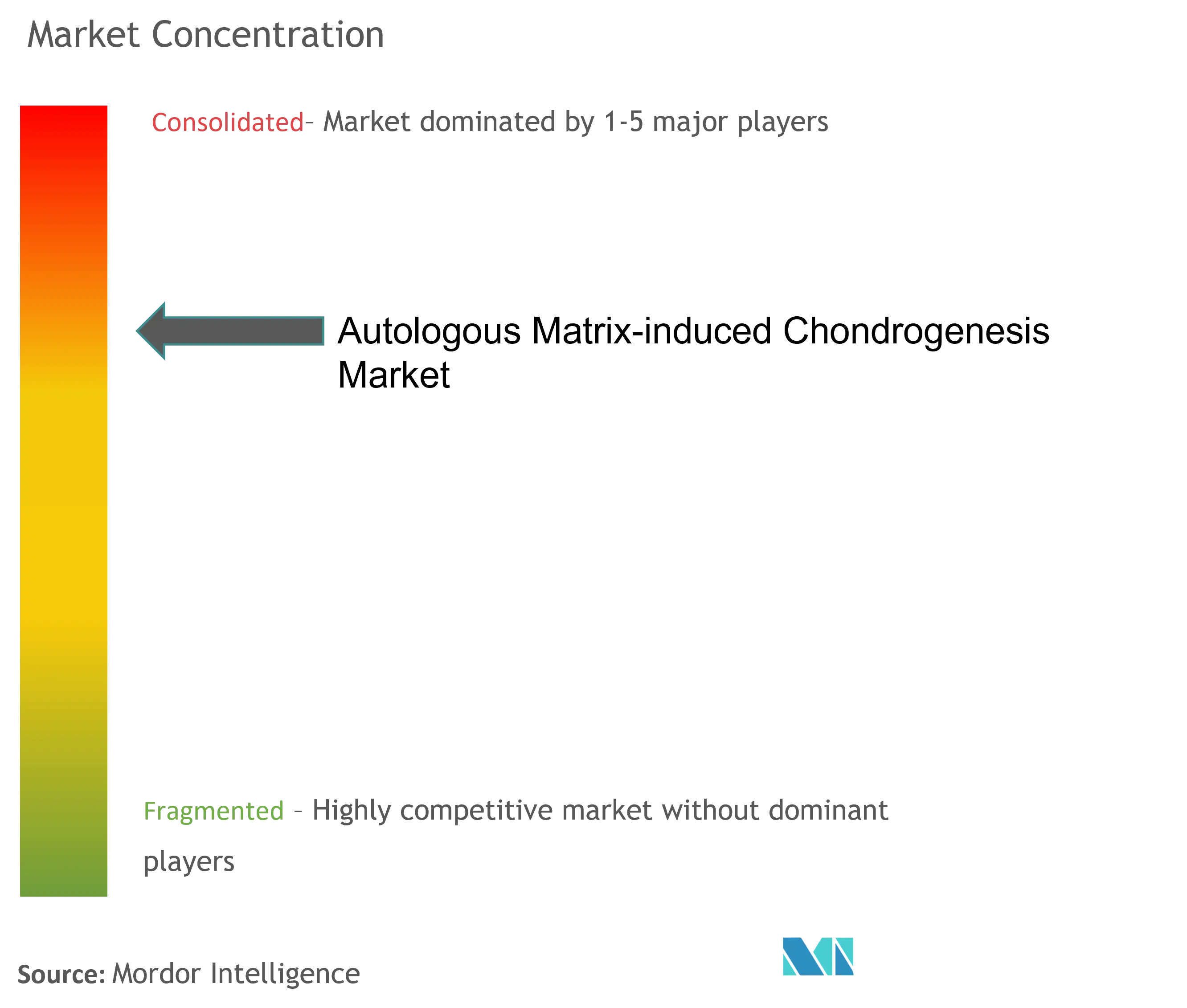Autologous Matrix-induced Chondrogenesis Market Analysis
The Autologous Matrix-induced Chondrogenesis Market is expected to register a CAGR of 8.1% during the forecast period.
- COVID-19 severely impacted the autologous matrix-induced chondrogenesis market, as many orthopedic surgeries were canceled or delayed to reduce the spread of infection during the early period of the pandemic. For instance, an article published in the Medicine journal in September 2022 revealed that authorities in many countries postponed hip and knee replacement surgeries to prevent the virus from spreading. In the United States, this resulted in the cancellation of 33 thousand primary hip and knee replacements every week until 2020, with roughly 130 thousand surgeries rescheduled. As a result, COVID-19 had a significant impact on the autologous matrix-induced chondrogenesis market. However, with the resumption of operations and a decrease in COVID-19 instances, the market is predicted to recover from the COVID-19 reduction over the forecast period.
- The rising prevalence of bone and joint disorders, increasing sports and other injuries, and growing demand for minimally invasive procedures are some of the factors driving market growth. Knee and hip replacement surgeries have increased globally in recent years, with persistent wound drainage being a well-known complication that commonly leads to wound development. The increase in surgical procedures is expected to drive demand for the autologous matrix-induced chondrogenesis market. For example, as per the June 2022 report of the Canadian Institute of Health Information, approximately 110 thousand joint replacements were performed in 2020-2021, and more than 7.3 thousand were performed as day surgery, representing a four-fold increase from the previous year, which is expected to drive the growth of the market segment.
- Furthermore, research studies demonstrating the advantages offered by autologous matrix-induced chondrogenesis are likely to increase opportunities for market growth. For instance, an article published in June 2022 in PubMed revealed that AMIC is useful for treating focal chondral abnormalities in the knee. Moreover, AMIC demonstrated a higher International Knee Documentation Committee (IKDC), a lower visual analog scale (VAS) value, and a lower rate of revision compared to microfracture (MFx). Similarly, an article published in November 2022 in PubMed revealed that according to the main findings of the study, the AMIC technique could be effective in improving symptoms and function in patients with osteochondral lesions (OCLs) of the talus. Statistically significant decreases in pain and enhancements of ankle function (AOFAS/FFI) were observed. Thus, such research studies demonstrate the advantages offered by autologous matrix-induced chondrogenesis and are likely to fuel market growth.
- However, the lack of a proper reimbursement system and the scarcity of skilled professionals are expected to hinder market growth. Overall, due to the rise in the prevalence of bone and joint disorders and the increase in research studies depicting the advantages of autologous matrix-induced chondrogenesis, the studied market is likely to witness notable growth over the forecast period.
Autologous Matrix-induced Chondrogenesis Market Trends
Knee Joint Holds Significant Share in the Global Autologous Matrix-induced Chondrogenesis Market Over the Forecast Period
- The knee cartilage segment is expected to experience substantial growth in the studied market due to several factors, including the increase in knee replacement surgeries, the rise in injuries, and the surge in minimally invasive procedures. According to the American Academy of Orthopaedic Surgeons (AAOS) 2021 report, nearly one million total knee replacement surgeries were performed in the United States in 2021, and the annual number is projected to rise to 3.5 million by 2030.
- Moreover, many research works are focused on the advantages of autologous matrix-induced chondrogenesis (AMIC) in knee replacements and surgeries. For instance, a ScienceDirect article published in November 2022 found that utilizing AMIC with a hyaluronic acid scaffold for the healing of chondral lesions of the knee yielded satisfactory clinical results in the short and medium term. This procedure improved symptoms, sports activities, and functionality and resulted in a high level of satisfaction among evaluated patients.
- Additionally, the rise in sport injury cases leads to knee surgeries, and AMIC is expected to drive market growth. For example, exercise equipment accounted for about 409,000 injuries, the most in any category of sports and recreation, according to the National Safety Council (NSC) in 2021. Since the AMIC technique is a promising cartilage resurfacing procedure, it is widely utilized in knee surgeries and replacements that occur during sports and recreational activities.
- Therefore, due to the rise in the prevalence of sports injuries and the increase in knee replacement and surgery involving autologous matrix-induced chondrogenesis, the studied segment is likely to witness significant growth over the forecast period.
North America Anticipated to Hold a Significant Market Share Over the Forecast Period
- North America is projected to hold a substantial market share in the studied market due to various factors. Firstly, there has been an increasing incidence of bone and joint disorders in the region, alongside a rising geriatric and obese population.
- For instance, according to the Congressional Budget Office's January 2023 update, the percentage of people aged 65 or older relative to the number of people aged 25 to 64 is expected to rise from 34% in 2023 to 46% in 2053 in the United States. As the geriatric population grows, there is an increase in bone and joint issues due to the reduction of essential growth factors as a result of aging. This is likely to lead to a rise in the adoption of autologous matrix-induced chondrogenesis over the forecast period.
- Secondly, an increase in sports injuries is expected as approximately 35 million children between the ages of 5 and 18 participate in organized sports each year in the United States, as per the 2023 update by UC DAVIS Health, Sports Medicine. More than 3.5 million kids under the age of 14 receive medical treatment for sports injuries each year. Thus, an increase in sports injuries is expected to undergo surgeries, thereby fueling the growth of the market studied.
- Moreover, there is an increasing awareness of newly introduced treatment procedures and technologies among physicians and patients in the region. Alongside this, substantial investments by the government in the technologies and therapies adopted for cartilage regeneration are supporting the growth of the market in North America.
- For instance, the Burden of Osteoarthritis in Canada 2021 report highlights that about 15% of Canadians aged 20+ have osteoarthritis (OA) in 2021. More than 4 million Canadians, or about 1 in every 7 adults, have OA. Hence, the high prevalence of OA is likely to augment the demand for the market studied over the forecast period.
- Therefore, due to the rise in the prevalence of sports injuries, the increasing geriatric population coupled with the risk of osteoarthritis, North America is expected to hold a significant market share over the forecast period.
Autologous Matrix-induced Chondrogenesis Industry Overview
The autologous matrix-induced chondrogenesis market is consolidated and consists of a few major players. Companies like Anika Therapeutics, Inc., Arthro-Kinetics, B. Braun SE, CartiHeal, Geistlich Group (Geistlich Pharma AG), JRL Orthopaedic Ltd, Matricel GmbH, Smith+Nephew, Zimmer Biomet Holdings, among others, hold the substantial market share in the market.
Autologous Matrix-induced Chondrogenesis Market Leaders
-
Anika Therapeutics, Inc.
-
Arthro-Kinetics
-
JRL Orthopaedic Ltd
-
Geistlich Group (Geistlich Pharma AG)
-
B. Braun SE
- *Disclaimer: Major Players sorted in no particular order
Autologous Matrix-induced Chondrogenesis Market News
- October 2022: Collagen Matrix, Inc. and Linden Capital Partners acquired BV Polyganics, a medical technology company that develops and manufactures bioresorbable medical devices. The acquisition expands Collagen Matrix's portfolio of bioresorbable solutions and technology platforms for bone and tissue repair, unlocking new markets and clinical opportunities for the Company.
- May 2022: Collagen-based solutions provider Rousselot showcased its latest Colartix ingredient, a collagen matrix from natural cartilage for joint care, at Vitafoods Europe 2022. The ingredient made from naturally occurring collagen peptides and glycosaminoglycans (GAGs) was recently shown in a 'real life' study to steadily decrease joint discomfort across demographics.
Autologous Matrix-induced Chondrogenesis Industry Segmentation
As per the scope of the report, AMIC is a single-stage cartilage regeneration approach in which a cell-free collagen matrix is implanted into a defective cartilage, combined with microfracture. These treatments have proven better outcomes as compared to conventional techniques.
The autologous matrix-induced chondrogenesis market is segmented by material (hyaluronic acid, collagen, polyethylene glycol (PEG), poly lactic-co-glycolic acid (PLGA), and other materials), application (knee cartilage, elbow cartilage, and other applications), and geography (North America, Europe, Asia-Pacific, Middle East, and Africa, South America). The report also covers the estimated market sizes and trends for 17 countries across major regions globally.
The report offers the value (in USD) for the above segments.
| By Material | Hyaluronic Acid | ||
| Collagen | |||
| Polyethylene Glycol (PEG) | |||
| Poly Lactic-co-glycolic Acid (PLGA) | |||
| Other Materials | |||
| By Application | Knee Cartilage | ||
| Elbow Cartilage | |||
| Other Applications | |||
| Geography | North America | United States | |
| Canada | |||
| Mexico | |||
| Europe | Germany | ||
| United Kingdom | |||
| France | |||
| Italy | |||
| Spain | |||
| Rest of Europe | |||
| Asia-Pacific | China | ||
| Japan | |||
| India | |||
| Australia | |||
| South Korea | |||
| Rest of Asia-Pacific | |||
| Middle East and Africa | GCC | ||
| South Africa | |||
| Rest of Middle East and Africa | |||
| South America | Brazil | ||
| Argentina | |||
| Rest of South America | |||
Autologous Matrix-induced Chondrogenesis Market Research FAQs
What is the current Autologous Matrix-induced Chondrogenesis Market size?
The Autologous Matrix-induced Chondrogenesis Market is projected to register a CAGR of 8.1% during the forecast period (2025-2030)
Who are the key players in Autologous Matrix-induced Chondrogenesis Market?
Anika Therapeutics, Inc., Arthro-Kinetics, JRL Orthopaedic Ltd, Geistlich Group (Geistlich Pharma AG) and B. Braun SE are the major companies operating in the Autologous Matrix-induced Chondrogenesis Market.
Which is the fastest growing region in Autologous Matrix-induced Chondrogenesis Market?
Asia Pacific is estimated to grow at the highest CAGR over the forecast period (2025-2030).
Which region has the biggest share in Autologous Matrix-induced Chondrogenesis Market?
In 2025, the North America accounts for the largest market share in Autologous Matrix-induced Chondrogenesis Market.
What years does this Autologous Matrix-induced Chondrogenesis Market cover?
The report covers the Autologous Matrix-induced Chondrogenesis Market historical market size for years: 2019, 2020, 2021, 2022, 2023 and 2024. The report also forecasts the Autologous Matrix-induced Chondrogenesis Market size for years: 2025, 2026, 2027, 2028, 2029 and 2030.
Our Best Selling Reports
Autologous Matrix-induced Chondrogenesis Industry Report
Statistics for the 2025 Autologous Matrix-induced Chondrogenesis market share, size and revenue growth rate, created by Mordor Intelligence™ Industry Reports. Autologous Matrix-induced Chondrogenesis analysis includes a market forecast outlook for 2025 to 2030 and historical overview. Get a sample of this industry analysis as a free report PDF download.







